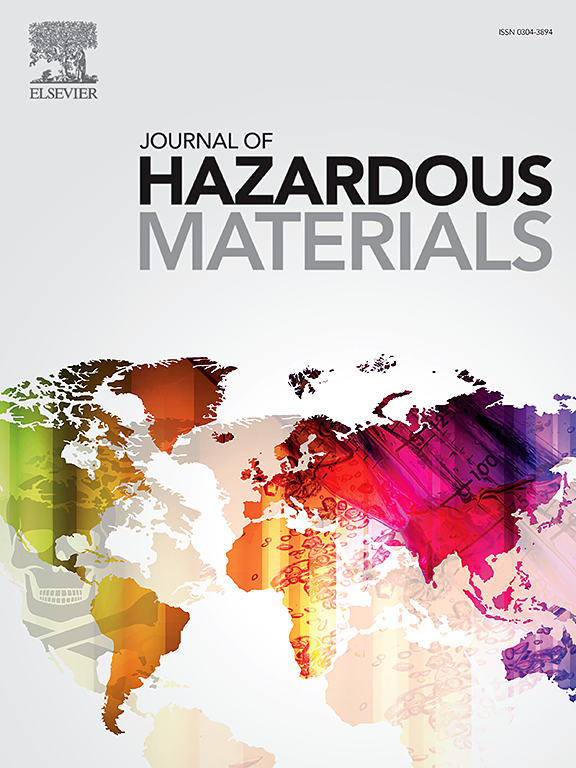电场驱动的特定离子效应对重金属共污染水生系统中纳米塑料聚集的机制见解
IF 12.2
1区 环境科学与生态学
Q1 ENGINEERING, ENVIRONMENTAL
引用次数: 0
摘要
纳米塑料和重金属的同时污染对相关水生系统构成了新的威胁。为了阐明纳米塑料-重金属聚集的界面机制,明确电场在这些过程中的作用,系统地研究了Pb 2 +、Cu 2 +、Cd 2 +和Zn 2 +介导的羧基改性聚苯乙烯纳米塑料(PNs)的聚集。定量分析显示,离子对PNs聚集有明显的特异性影响,如临界凝血浓度(CCC: Pb2+ (1.6 mM) <;Cu2+ (4.6 mM) <;Cd2+ (13.9 mM) <;Zn2+ (16.6 mM))和效应强度与电场强度成正比。进一步的理论计算和相关分析表明,PNs表面的强界面电场(-1.23×10⁸V/m)诱导了PNs表面的极化增强感应力和极化诱导的重金属阳离子与O之间的共价键。这些电场依赖的相互作用对PNs聚集的贡献超过41%,说明了观察到的特定离子效应,FTIR和XPS结果证实了这一点。我们的研究结果为理解纳米塑料的命运提供了范式转变,为相关流域多污染物的预测建模和修复策略提供了重要见解。本文章由计算机程序翻译,如有差异,请以英文原文为准。

Mechanistic insights into electric field-driven specific ion effects on nanoplastics aggregation in heavy metal co-contaminated aquatic systems
The concurrent pollution of nanoplastics and heavy metals poses emerging threats to relevant aquatic systems., To elucidate the interfacial mechanisms governing nanoplastics-heavy metal aggregation, specifically clarify the unreconized role of electric fields on these processes, systematic investigation of carboxyl-modified polystyrene nanoplastics (PNs) aggregation mediated by Pb²⁺, Cu²⁺, Cd²⁺ and Zn²⁺ were conducted. Quantitative analyses revealed distinct specific ion effects on PNs aggregation, as evidenced by critical coagulation concentrations (CCC: Pb2+ (1.6 mM) < Cu2+ (4.6 mM) < Cd2+ (13.9 mM) < Zn2+ (16.6 mM)) and effect magnitudes intensifying proportionally to electric field strength. Further theoretical calculations and correlation analyses demonstrated that the strong interfacial electric field (-1.23×10⁸ V/m) at PNs surfaces induces polarization-enhanced induction force and polarization-induced covalent bonding between heavy metal cations and O on the PNs surface. These electric field-dependent interactions contributed more than 41% to PNs aggregation, accounting for the observed specific ion effects, corroborated by FTIR and XPS results. Our findings provide a paradigm shift in understanding nanoplastics fate, offering critical insights for predictive modeling and remediation strategies of multi-pollutant in relevant watersheds.
求助全文
通过发布文献求助,成功后即可免费获取论文全文。
去求助
来源期刊

Journal of Hazardous Materials
工程技术-工程:环境
CiteScore
25.40
自引率
5.90%
发文量
3059
审稿时长
58 days
期刊介绍:
The Journal of Hazardous Materials serves as a global platform for promoting cutting-edge research in the field of Environmental Science and Engineering. Our publication features a wide range of articles, including full-length research papers, review articles, and perspectives, with the aim of enhancing our understanding of the dangers and risks associated with various materials concerning public health and the environment. It is important to note that the term "environmental contaminants" refers specifically to substances that pose hazardous effects through contamination, while excluding those that do not have such impacts on the environment or human health. Moreover, we emphasize the distinction between wastes and hazardous materials in order to provide further clarity on the scope of the journal. We have a keen interest in exploring specific compounds and microbial agents that have adverse effects on the environment.
 求助内容:
求助内容: 应助结果提醒方式:
应助结果提醒方式:


